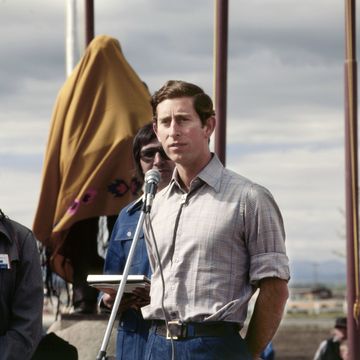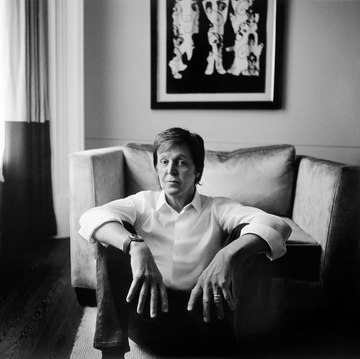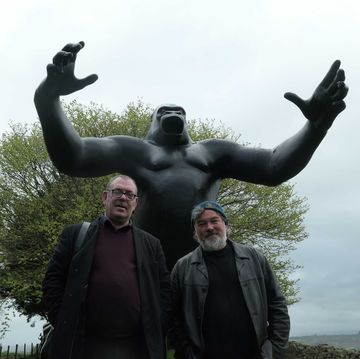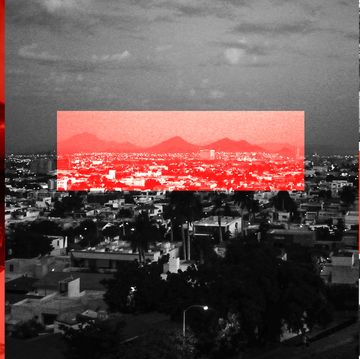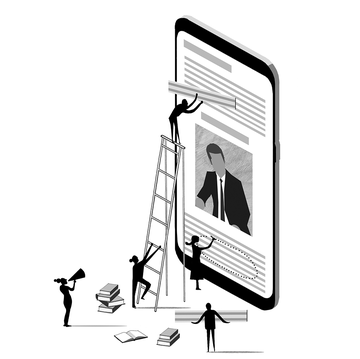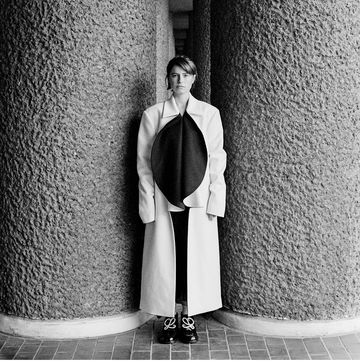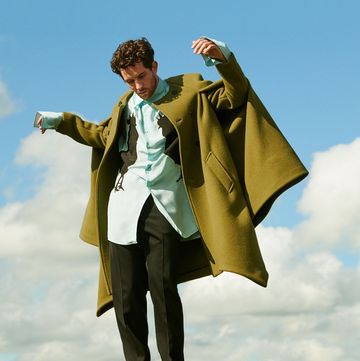America is the greatest country on Earth. If you don't believe it, just ask an American. We love it so much that about 96 per cent of us never go anywhere else. Hey, we have the Grand Canyon, the Hollywood Walk of Fame, Disneyworld, Mall of America, the Freedom Tower and Ground Zero.
What is there to find in Europe? Old things. In Africa? Tropical diseases. In Asia? Teeming masses and sweatshops. Why would anyone want to go anywhere else if you've been to America?
Well, some might want to go to Iraq, to Afghanistan and other troubled nations that require our tutelage and competence — in other words, Americans might want to kill 'em over there so we don't have to kill 'em here. But the Land of the Free and the Home of the Brave has got it all! We've got the tallest buildings, the most nukes, the best athletes (except those who are limited to using their feet and heads) and the biggest armed forces, with a budget as big as the eight next largest military powers in the world combined. People brag about French, Italian and Japanese food, but what about cheese fries, stuffed crust pizza, and the Fatburger XXXL? Hell, most of us think that God must be an American.
That's why we have our own sort of creed called American Exceptionalism. The idea goes all the way back to the original British colonists, who believed, "We shall be as a city on a hill — the eyes of all people are upon us."
All eyes on us! No wonder we have issues with our appearance, with style and fashion. If all eyes are upon us, we'd better look exceptional, but exceptional in an American way: manly men of action, not spiffy ponces and gussied up gits. American style is rugged but casual. We love to see the American Revolution depicted as the casually attired sharpshooter rustics picking off the stiff redcoats, like sitting ducks in their formal ranks. It was a triumph of efficiency over formality. We're Americans; we improvise and get the job done. A victory of denim and boots over Worsteds and Oxfords. We don't mind getting our hands dirty.
Historically, America's elite was far different from the British aristocracy. In America, gentlemen would forego peacockery and powdered wigs, instead dressing simply, emphasising cleanliness, physical fitness and restrained colours, which were the main attributes of the style revolution usually credited to the London dandy Beau Brummell a few years later.
America's great fashion influences were the horseman and the working man. Strong, masculine, competent. You could say that American work clothes embodied our sensibility: durable, plain, improvisational and practical.
The great icon of American style is the cowboy — an exotic concoction of Native American, caballero, Buffalo soldier and redneck. His look showed what he did for a living, but also that he was a freelance, an itinerant adventurer. The perfect combination of ten-gallon hat, vest, chaps, jeans and boots made him a knight without commission, and his gear, relaxed in attitude but inspired by action, set the style for American working men, from farmers and cattlemen to construction workers and wildcatters.
We went on to invent all manner of action-oriented attire: dungarees or jeans, denim shirts, chinos, jump suits, sweat shirts (then sweatsuits), sneakers and all sorts of clothes derived from athletic and military gear. The button-down collar was introduced by America's original ready-to-wear tailors Brooks Brothers, modelled after polo players' shirt collars, which buttoned down to avoid flapping in the wind.
The bomber jacket, the denim jean jacket and the motorcycle jacket, particularly the Schott Perfecto, which made generations look tough, from Brando to James Dean to The Ramones. We've gone through periods where cargo pockets were actually considered fashion, and one of the big trends in American men's fashion in recent years is the use of camouflage in such areas as underwear, neckties and blazers.
The casual revolution in menswear has carried on for hundreds of years now, simplifying all the time. In the past decade, much of the traditional business outfit has been discarded.
American men have generally avoided hats for the past half- century. Once worn by nearly everyone, the hat, from newsboy or golf cap to the topper, fell out of favour, according to some because the stylish John F Kennedy didn't like them. But sometimes a man has to wear a hat, and for Americans the nearly unanimous choice is the baseball cap, which now dominates sports from hunting to golf, and has become standard military issue. It's functional, it folds up and guys are comfortable in it because they've been wearing it since boyhood. And because it generally bears a logo, it's a status symbol that specifies allegiances and attitudes, from Titleist golf balls to "Fuck tha Police", from Blood to Crip. Today, the traditional hat is so far gone that we see businessmen walking in the snow on Madison Avenue in camel hair polo coats and New York Yankees baseball caps — a rather depressing sight.
Americans love uniforms, even civilian uniforms. In Western Pennsylvania, the most common form of dress for both men and women is the Pittsburgh Steelers jersey. On Long Island, one will find many men on the job in a Derek Jeter #2 Yankees T-shirt.
What niceties American men do observe are greatly diminished. Even on formal occasions, Americans have tended to dress down. The tuxedo, which eliminated the tailcoat at the end of the 19th century, encouraged more lively dancing among men of action. Today the trend is creative black tie, which often seems to mean "no tie".
One area where America clearly leads the world is fatness — tipping the scales heavier than any country in the world, even those Pacific Islands where they grow linemen for American football. The average UK inhabitant is 10 pounds slimmer. We can only predict a fashion version of the jumpsuit to emerge soon, perhaps with exterior handles for assistance in vehicle loading and unloading.
British and European tailored garments are generally cut with a slimming waist. American boys are told that this is because the Brits, even those residing below Hadrian's Wall, lack central heating and thus prefer their Worsteds closer to the skin. The terrible truth about the sack suit and the blousey Ivy League shirt may not be known until years later when a man investigates such things as collar expanders.
America has a long tradition of the sack suit, which is exactly as it sounds — no waist suppression and "natural shoulder", ie, little or no shoulder padding. It may have been a prophetic cut in that it foretold what the American physique would increasingly become. It was associated with the "Ivy League" or Brooks Brothers style. It certainly made for a relaxed look, but nature, and brewers, abhor a vacuum.
When the sack suit was introduced a century ago it was primarily a "leisure suit", being what men wore when not engaged in business, which was the traditional frock coat. It was inherently ready-to-wear since fit was not really an issue. But America, being the land of the free and the relaxed, adopted the sack as business wear, ditching the frock coat altogether. The sack forgave the bloated figure, and as the 20th century progressed, the American man, including Wall Street bankers, politicians and students of the swankiest universities, were wearing the sack. Before long, bodies began to match their wrapping.
Although the sack became the American standard, it was not an international style, with the British and Italians still exhibiting some pride in the figure through mastering the art of the cut where it became concealing, correcting, even prosthetic.
Surprisingly, American tailoring had a revolution of its own with the arrival of the daring Thom Browne, whose suits featured radically shorter jackets with slim lapels and narrow trousers (and shorts). Ironically, Browne's suits featured many elements of the All-American wardrobe and adapted it for a leaner, more body conscious and flamboyant man. While Thom Browne seemed extreme in his cut, to the point where it clearly seemed a fad, the fashion world didn't see it that way. Virtually every significant designer or tailoring company wound up accommodating Browne's eye, and suddenly every suit in your wardrobe was obsolete.
But was the suit itself extinct as the default menswear mode? How often have I seen a girl on the street in a pretty little dress and high heels, immaculately groomed, accompanied by a guy in a T-shirt or polo, jeans and Seinfeld sneakers? And how often have I thought, "I hope he's her driver, not her date"?
We still have a suit-wearing class, but it's not what it was. Although the suit is still the corporate uniform in many situations, it's also what the copier repairman wears. Steve Jobs, whatever you think of his style, changed the image of the entrepreneur/executive forever. We work differently. Rich people rarely wear suits to show off, they wear four-figure limited edition sneakers. "Creatives" wear denim shirts and jeans or khakis. In fact, the people who once were white collar are now in blue, and vice versa.
This is the sad, fundamental problem of American style. You either have it or you really, really don't. Many American men are afraid of style. Some of the style- evaders are simply trying to keep a low profile, thinking if they aren't noticed they won't get in trouble. Then there is the styleless guy who thinks the entire field is feminine, the rebel without a style, the rebel without a clue. He wears a stars 'n' stripes pin (or maybe stars and bars) on his Carhartt jump suit, and threatens to put a Timberland up your union suit.
Then, of course, we have another category of men's style — the corrective. This is an innovative redesign of men's style that is truly All-American. It's about making the best of what you've got. Put on your elevator shoes and check out the UNTUCKit!
UNTUCKit! No, it's not a spot on the Massachusetts shoreline. It's the shirt specially designed to be untucked. America is the land where big and tall speciality shops sprung up. But these shops merely offered a greater range of sizes. The UNTUCKit shirt literally reshapes the man of substance into a more casual and relaxed creature. This was done scientifically by showing a focus group of nubile females photos of men in untucked shirts of varying length. According to the surprisingly literate UNTUCKit founder Chris Riccobono, one doesn't want to "butcher the 'divine proportions' made famous by Da Vinci's Vitruvian Man". According to the babe allure research, the Vitruvian Man's shirt hits man at mid-zipper.
Is the untucked shirt really more casual, or is it simply a disguise for beer belly and love handles and added protection against "lorry driver's butt"? American style, beginning with the sack suit (and the sack dress) is intended to conceal obesity.
Why are Americans afraid of travelling abroad? Well, clearly there are foreigners out there. And Americans may feel targeted because it's so easy to identify them. I'm always flattered when someone asks me for directions in London, Rome or Paris. It means I'm passing. Is it just because I'm not wearing a sun visor, fanny pack, fisherman's vest, cargo pants and walking shoes? I don't think it's that simple. I just look like I've been around the block before. I've been where 96 per cent of my countrymen haven't been, and I went shopping there.
Essay taken from the Esquire Big Black Book S/S 16 issue.



